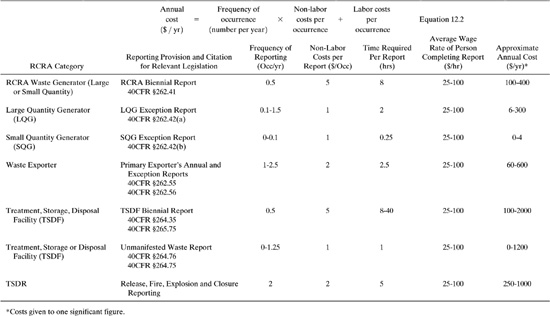Appendix E
Procedures for Estimating Hidden (Tier II) Costs
Regulatory costs are often charged to overhead, and are therefore “hidden” when project costs are evaluated. Hidden personnel costs are often difficult to account for because environmental reporting and recordkeeping are frequently performed by staff who divide their time between many different processes and facilities. Nevertheless, it is possible to estimate the time required to meet notification, reporting, manifesting and other administrative tasks associated with environmental compliance. Tables E-1 to E-5 give methods for estimating the notification, reporting, recordkeeping, manifesting, and labeling costs required by the Resource Conservation and Recovery Act (RCRA) for hazardous waste generation. Methods for esti-mating the costs associated with compliance with other statutes are available from the EPA (U.S. EPA, 1989). Tables E-1 to E-5 show that the level of reporting and recordkeeping required depends on whether a facility is a large- or small-quantity-generator of hazardous waste, whether it exports hazardous waste, and on whether they are considered to be a treatment, storage, and disposal site. Costs are esti-mated by multiplying the frequency of oxccurrence of reporting and recordkeeping activities by their non-labor and labor costs per occurrence. These tables also show that associated costs depend on the skill and cost of the labor involved and on the frequency of violations. Other RCRA reporting requirements include those for monitoring and testing; planning, studies and modeling; training; inspections; preparedness and protective equipment; closure and post closure assurance; and insurance and special taxes.
The following example illustrates the use of the tables.
Example E-1 Estimating Regulatory Recordkeeping and Reporting Costs for RCRA.
Estimate the costs of RCRA reporting, recordkeeping, manifesting, and labeling for a small-quantity generator of hazardous waste. Assume that the facility generates five drums of hazardous waste per year and that this waste is sent off-site for disposal. Pick-up of the waste occurs quarterly (4 times per year). To produce your estimate, use the upper value of the wage ranges, the midpoint of the ranges for time required, and the lowest value for frequency when a range of these variables is given in the tables.
Solution: To estimate reporting costs (Table E-2):
![]()
The facility is a RCRA waste generator and must fill out the RCRA Biennial Report every other year at a cost of $400/year.
The lowest frequency for filling out Small Quantity Generator (SQG) Exception Reports is zero, so the estimated cost of filling them out is zero.
Recordkeeping costs (Table E-3):
The facility is a RCRA waste generator and its recordkeeping costs are
![]()
Manifesting costs (Table E-4):
The facility sends its waste for disposal and the manifesting costs are

Labeling costs (Table E-5):
An estimate of labeling costs for the facility is
![]()
The total estimated costs are
![]()
Regulatory recordkeeping and reporting requirements are not confined to RCRA. There are other federal requirements, such as reporting in the Toxic Chemical Release Inventory (TRI), and state and local requirements can also be significant.
Table E-1 Estimation Methods for RCRA Notification (US EPA, 1989).

Table E-2 Estimation Methods for RCRA Reporting (US EPA, 1989).

Table E-3 Estimation Methods for RCRA Recordkeeping (US EPA, 1989).

Table E-4 Estimation Methods for RCRA Manifesting (US EPA, 1989).

Table E-5 Estimation Methods for RCRA Labeling (US EPA, 1989).

